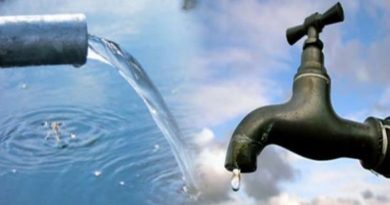SRADev Nigeria wants regulation to ban paints with total lead concentration
A Non-Governmental Organisation, Sustainable Research and Action for Environmental Development (SRADev Nigeria) has called on the federal government to draft a regulation that will ban the manufacture, import, export, distribution and use of paints that contain total lead concentrations exceeding 90 ppm, the most restrictive standard in the world.
Besides, that they should also require paint companies to display sufficient information indicating harmful content on paint can labels such as solvents and provide a warning on possible lead dust hazards when distributing painted surfaces.
The call came following a recent study carried out from July to August 2016 on lead in “Solvent-based Paints for Home Use in Nigeria” under the auspices of the international POPs Elimination Network (IPEN) where key findings below were discovered by the organisation.
• 40 out of 54 analyzed solvent-based paints for home use (74 percent of paints) were lead paints, i.e., they contained a total lead concentration above 90 parts per million.
• 29 paints (54 percent of paints) contained dangerously high lead concentrations above 10,000 ppm. The highest total lead concentration detected was 160,000 ppm, this is nearly 1,800 times the 90 ppm.
• 26 percent of paints (14 out of 54) for home use contained total lead concentrations at or below 90 ppm, suggesting that the technology to produce paint without lead ingredients exists in Nigeria.
• Paints with yellow (89 percent) and red(67 percent) colors most frequently contained dangerously high levels of lead above 10,000 ppm, compared to white (1 percent) coloured paints.
• Only 6 percent of paints(3out of 54 paints) provided information about lead on their labels and most paints carried little information about any ingredients on can labels.
At the public presentation of the report of the study in Lagos on Friday October 20, 2017, Executive Director of SRADev Nigeria, Mr. Ane Leslie Adogame, said lead is added to most paint to improve its covering power and durability, used during the production stage as drying agent for preservation of paints but unfortunately, lead is a powerful poison.
He went further, “Both inside and outside the home, deteriorated lead-paint mixes with household dust and soil. Children may become lead poisoned by: Putting their hands or other lead-contaminated objects into their mouths, eating paint chips found in homes with peeling or flaking lead-based paint, Kids eat peeling paint; it tastes like lemon drops or playing in lead-contaminated soil. Lead is more dangerous to children because: Children’s growing bodies absorb more lead and Children’s brains and nervous systems are more sensitive to the damaging effects of lead.
“Lead exposure is a well-known source of harm to children’s health that can cause adverse lifelong effects, such as decreased intelligence, poor school performance, mental retardation and violent behavior. Its exposure in childhood is now known to be associated with lower vocabulary and grammatical-reasoning scores, increased absenteeism, poorer eye-to-hand coordination, and lower class standing in high school. It is therefore important that sources of lead hazards such as lead paint and dust in children’s environment be identified and minimized, if not entirely and safely removed, to protect kids from such harm.
“At low levels, it reduces a person’s intelligence, makes him/her difficult to concentrate or pay attention, and harms hearing. These effects are permanent. Naturally, in children, these effects reduce performance in school. At higher levels, lead has many additional severe effects including kidney disease, blindness, seizures, and death. “There is no acceptable blood lead level in children that is considered safe; hence the need for society to adopt essential precautionary and preventive policies and practices to ensure a lead-safe environment for all kids,” he explained.
The SRADev boss disclosed that a recent study investigating the economic impact of childhood lead exposure on national economies in all low- and middle-income countries estimated a total cumulative cost burden of $977 billion international dollars per year.
According to him, the study considered the neurodevelopmental effects on lead-exposed children, as measured by reduced IQ points while economic loss in Nigeria is estimated at $16.2 billion, or 3.94 per cent of Gross Domestic Product (GDP).
Adogame said “The Federal Government of Nigeria (Federal Ministry of Environment in collaboration with the NESREA, should immediately draft a regulation that will ban the manufacture, import, export, distribution, sale and use of paints that contain total lead concentrations exceeding 90 ppm, the most restrictive standard in the world. They should also require paint companies to display sufficient information indicating harmful content on paint can labels such as solvents and provide a warning on possible lead dust hazards when disturbing painted surfaces.”
Other recommendations he listed include “all stakeholders should come together and unite in promoting a strong policy that will eliminate lead paint in Nigeria. Stakeholders are encouraged to foster voluntary initiatives by paint manufacturers, importers of paints and paint chemicals, and vendors to phase-out the use of lead compounds in their products, even before any national legal instrument is adopted or enforced.
In a goodwill message, Federal Controller of Environment in Lagos, Mrs. O. Agbenla, represented by Mr. Asaolu Oyewole, an engineer, commended SRADev Nigeria for her efforts on the study adding that the report shows that most of the paints for home use available in the market in Nigeria have high concentrations of lead.
According to her, “This, therefore, calls for an urgent action by all stakeholders, the Federal Ministry of Environment, Standard Organisation of Nigeria and the Consumer Protection Council to adopt and be ready to enforce regulations that will totally ban the manufacture, distribution and use of paints with total lead concentrations greater than 90ppm.”
Representative of SON Director General, Mr. Steve Attahiru, said the reason why paints in Nigeria contains high lead content was because previous Standard does not have lead standard but that a new Standard that contains lead has been developed.
Representative of Paints Manufacturer Association of Nigeria, Mr Jude Maduka, said effect of lead in paints is not good for anybody but that they help less because it comes with the raw material they use in the manufacture paints.
The public presentation of the report which is part of the ongoing project “Lead Paint Elimination Campaign: Facilitating National Standard and Regulation in Nigeria” being carried out July-December 2017 was also organised to mark the 5th International Lead Poisoning Prevention Week of Action (ILPPWA) with “Ban lead paint” as theme.
Other highlight of the well attended report presentation by stakeholders including Federal and Lagos state officials, paint manufacturers, environmentalists, NGOs and media include presentation by schools for lead free paints.



